As a maker of appliqué thangkas and other artworks based on Tibetan appliqué, I’m often asked, “What exactly IS a thangka?”
Thangka is a Tibetan term for one of Tibet’s most plentiful and portable forms of sacred art. Some say the word thangka means “something that rolls up,” while others hypothesize that the word derives from thang-yig, which means “written record.” In this view, a thangka could be considered a pictorial or graphic record. Regardless of the etymology, the word “thangka” refers to a two-dimensional, rollable form of art—a scroll—illustrated with images of spiritual masters, teachers, enlightened beings, role models, and symbols of our buddha nature.
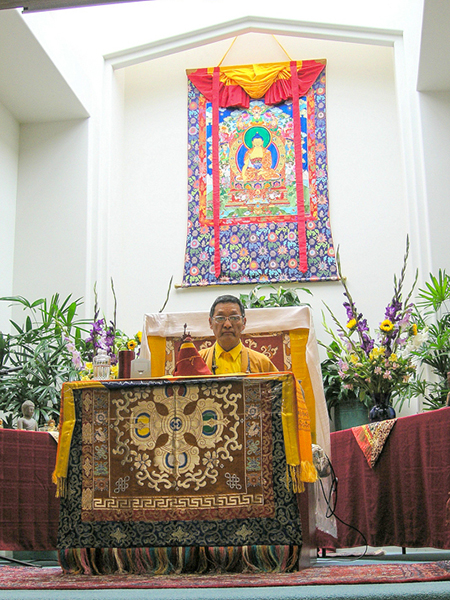
Gangteng Rinpoche teaching before a large appliqué thangka by Leslie Rinchen-Wongmo at Unity Church in Santa Barbara, CA in 2014
The idealized figures depicted on thangkas can be viewed in at least three different ways:
- as external entities — powerful, clear-seeing, compassionate guides, teachers, and helpers who can be called upon for support
- as models of our own future, images of the enlightened beings we will become when we’ve reached the destination of our spiritual journey
- as a true reflection of our own ever-present nature—already buddha—the natural sky-like freedom of our minds clouded only by temporary and illusory veils
Any of these views can be true, depending on which lens you look through. Visualization practices can be used to rehearse and uncover the second and third views as well as to pay homage and receive blessings in the first view.
However they’re regarded, the powerful and inspiring figures pictured on thangkas carry enormous power to uplift and transform viewers’ minds. But a thangka is more than just this inspiring picture. It is a composite object composed of a picture, a soft frame, and other elements which aid and enhance its display.
Numerous books and articles discuss Tibetan iconography and tell stories of the sacred figures contained in thangkas. But few talk about the thangka as a physical object created by artists and craftspeople and used by ordinary people in their homes and temples.
The physical object called thangka has the following key characteristics:
- Thangkas are pictorial — generally depicting spiritual figures and symbols.
- Thangkas are two-dimensional — they’re not sculptures.
- Thangkas are rollable — as opposed to wall paintings and sand mandalas and paintings in which canvas remains stretched on a wooden frame.
- A thangka is more than just a sacred image — it is a composite object consisting of a painted, embroidered, or appliqué picture surrounded by a soft frame of fabric.
The picture part of most thangkas is painted (traditionally with mineral pigments but nowadays often with acrylic colors) on cotton canvas. Throughout the painting process, this canvas is stretched on a rigid wooden frame. When the painting is finished, the artist cuts the painted canvas free from its rigid stretcher and takes it to a specialized tailor who will mount it in brocade and assemble it in an integrated display-store-and-transport package.
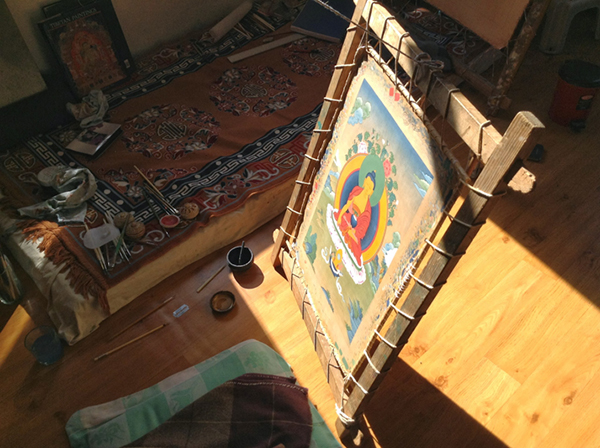
Thangka Painting in Progress
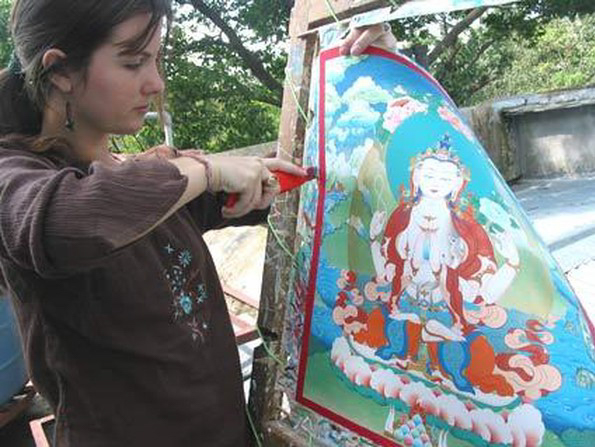
Tiffani Gyatso, a member of the Dakini As Art collective, cuts her completed thangka painting from its stretcher frame. Next it will be framed in brocade. See more of Tiffani’s artwork at tiffanigyatso.com.

Special brocade is woven in Varanasi, India for framing thangkas.
In some thangkas, not only the frame but the picture itself is constructed from fabric. These rare and precious thangkas are constructed from pieces of silk stitched together and embellished with embroidery and beads. This uniquely Tibetan textile art (usually called appliqué for lack of a better word) is the thangka tradition I studied.
The fabric mountings of early thangkas were often very simple. Rather than a rectangular frame that fully surrounds the picture, some were simple strips of blue cloth sewn along the upper and lower edges of the painting. The sides of the painting were left alone. In recent centuries, however, fabric frames have become more substantial and are usually made with multiple strips of multicolored brocade that surround the painting on all sides.
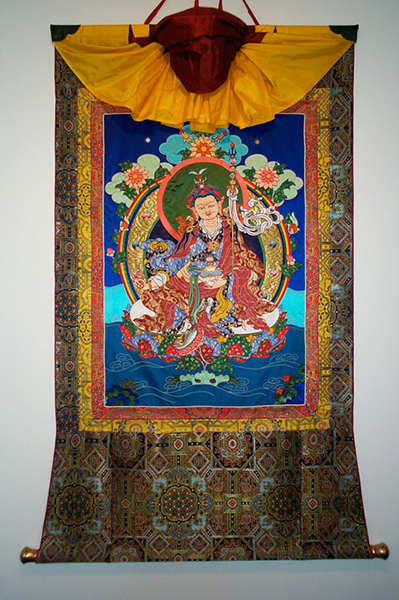
Guru Rinpoche appliqué thangka by Leslie Rinchen-Wongmo. Notice the “rainbow” strips of brocade surrounding the image, the slat at the top of the frame, dowel at the bottom, and veil decoratively arranged at the top.
The strips that surround the picture most closely on all sides are called the “rainbow.” This reminds us that the beings depicted in the picture are beings of light, radiating non-stop goodness to us all. Most commonly, the innermost strip is red, the next strip (or the frame itself) is yellow or golden, and the outermost color (if included) is blue.
Sometimes, a rectangular piece of contrasting brocade, referred to as a door, is incorporated into a wide rectangle of brocade at the bottom of the frame, below the painting. There is a slat along the top edge of the fabric frame that spreads the thangka flat against the wall as it hangs. Narrow fabric strips or strings attached to this top edge serve the dual purpose of suspending the completed thangka from a hook for display and keeping it securely rolled while storing and carrying.
A rod or dowel is inserted in a sleeve along the bottom edge of the fabric frame to provide rigidity and weight so that the entire thangka—picture and frame—will hang smoothly. It also serves as the axis around which the thangka is rolled for storage and transport.
Rolling a thangka is a two-person job: one person holds the upper slat keeping the thangka taut as the second person holds the lower dowel and rolls the thangka around it. If you find yourself rolling a thangka, take care to hold your hands near the ends of the dowel so that you’re squeezing the brocade border, rather than the picture itself. Also take care to wrap the securing strips loosely around the brocade border so they don’t put pressure the picture itself.
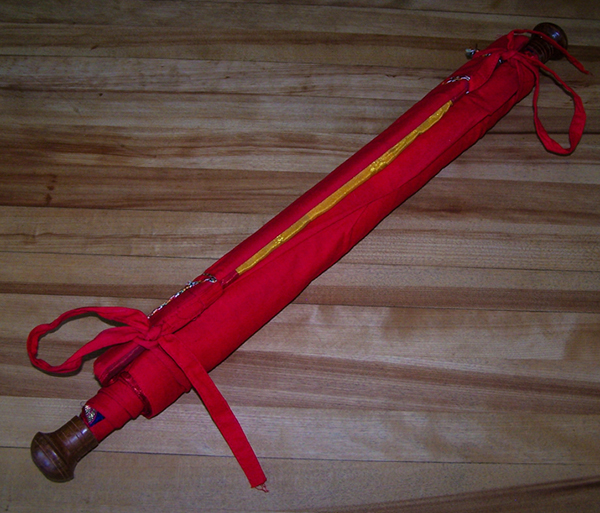
A thangka is a rollable scroll and its traditional design is an integrated display-storage-transport system. Take care to secure ties around the brocade borders, so as not to damage the painting.
Two additional features are usually incorporated into the thangka’s framing assembly: a veil (or drape) and ribbons. In Tibetan, the veil is called a “face-cover.” It is made of a soft, flowing silk fabric, much thinner than the heavy brocade of the frame. One end of the veil is attached at the upper edge of the frame, along the wooden slat. From there, it flows down to cover the entire face of the thangka. When the veil is lowered, it protects unauthorized eyes from viewing the image.
For display, this veil is gathered and tucked under a string that runs along the front of the upper slat. (Don’t use this string to hang the thangka. It’s only designed to hold the weight of the veil! See previous How to Hang a Thangka blog post for details.) Tucked up, the veil creates a decorative flourish above the picture, giving it a celebratory and honored look. It’s like arranging flowers and putting on our best clothes for a respected guest. For detailed instructions on how to arrange the thangka veil, visit my earlier blog post on the subject.
The ribbons can hang down in front of the thangka add to the celebration or they can be hidden behind. Known as “wind strips,” the ribbons were originally intended to hang in front of the painting only when the veil was lowered – they prevented the veil from blowing in the wind and thus revealing the image unintentionally.
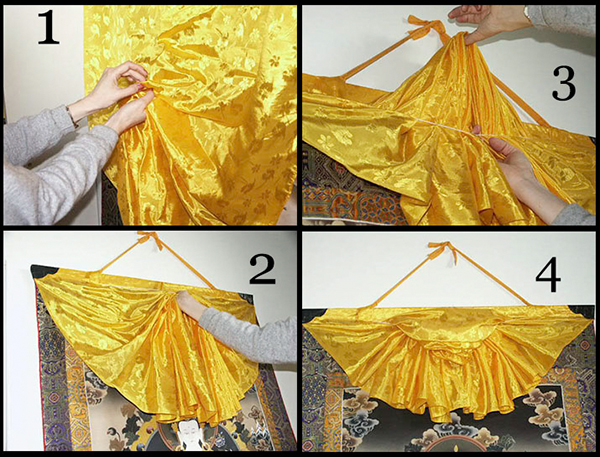
When the veil is lowered over the face of the thangka, it protects unauthorized eyes from viewing the image. Gathered and arranged above the image, it creates a decorative flourish to honor the deity. For detailed instructions on how to arrange the thangka veil visit https://threadsofawakening.com/how-to-arrange-the-draped-silk-thangka-cover.
This display-transport-storage integration has proved functional over centuries in the Tibetan monastic and semi-nomadic context, and is worthy of great admiration. In terms of conservation, however, the traditional package and its handling pose challenges for the long-term preservation of artworks. Though the upper slat and the lower rod do keep the thangka from bending and wrinkling when rolled, paintings are nonetheless stressed and gradually degraded with repeated rolling and unrolling. Flat methods of framing and storage are kinder to the artwork and should be considered in contexts where preservation is considered important.
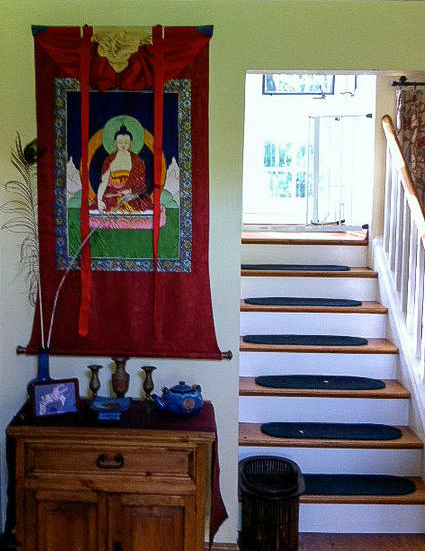
Appliqué thangka by Leslie Rinchen-Wongmo hanging in a private home in California.

